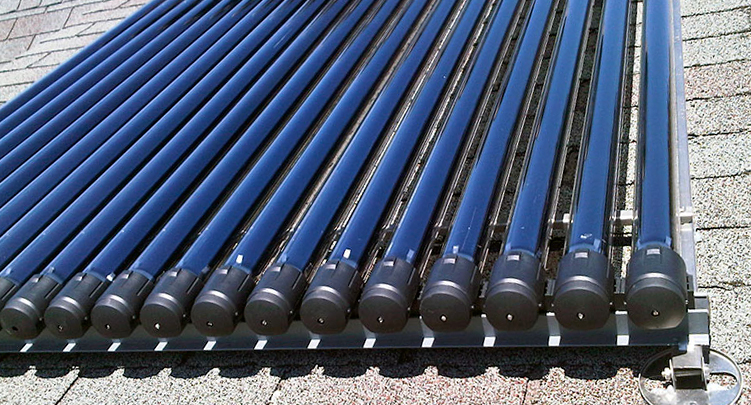
Solar evacuated tube or vacuum tube collector comprises a number of rows of parallel transparent glass tubes connected to the header pipe and where the heat transfer fluid (generally 50% Propylene Glycol) circulates and absorbs heat generated by the tubes.
The glass tubes have a cylindrical shapes. You should always choose the collectors that provide the optimal combination of thermal performance, quality, and cost. That’s why solar evacuated tube collectors are superior to flat plate collectors for solar heating purposes in northern climates.
Generally, evacuated tube collectors deliver better performance in cold climates than flat plate collectors. Flat plate collectors are more susceptible to ambient heat loss because the fluid being heated has a considerable residence time in the flat plate collector as it travels throughout the solar collectors. The fluid present in a solar evacuated tube flows through the header manifold which minimizes the residence time.
A solar system is tilted towards capturing the solar energy during winter to improve the solar energy while minimizing solar energy during summer. However, flat panels have a solid structure that catches the wind when tilted up on the roof. It results in becoming a hazardous projectile during wind storms.
Solar vacuum tubes have significantly less drag because of the spaces present between the tubes that allow the wind through. They are able to mount on the roof at a steep angle. Due to this reason, these collectors can provide heat year-round.
The sun traverses from the east to the west in the sky. The evacuated tube collectors have a tubular design. They are within 40 degrees of due south and always facing the sun as well as the absorbing maximum amount of solar energy automatically. But the flat plate collectors absorb the maximum amount of solar energy only during noontime.
It’s better to consider the panel area, title angle, and orientation as well as collector efficiency parameters like optimal energy conversion, heat-loss coefficient, and incident angle adjustment between flat plate and vacuum tube collectors. By comparing them, it’s shown that solar evacuated tube collectors are considered more efficient in northern climate conditions.
You should consider the versatility of solar evacuated tube collectors over flat plate collectors. Vacuum tube collectors are perfect to use for residential and commercial applications. They can be used with residential hot water, radiant floor/space heating, solar pool heater, spa and hot tub heater, and commercial solar water heating system.
Final Consideration –
For the above-discussed reasons, Latitude51 Solar recommends you install solar evacuated tubes collectors for cold climate conditions. Highly operational and efficient evacuated tube design permits high tilt roof mounting without any significant wind load.
Moreover, the tubular heat pipes extend the time period of collecting solar energy. If you want to learn more about our solar evacuated tubes collectors, feel free to contact us as soon as possible at 1 800 317 9054 and we’ll get back to you right away.

